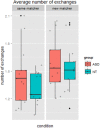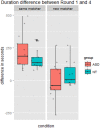Global Similarities and Multifaceted Differences in the Production of Partner-Specific Referential Pacts by Adults with Autism Spectrum Disorders
- PMID: 26733897
- PMCID: PMC4681838
- DOI: 10.3389/fpsyg.2015.01888
Global Similarities and Multifaceted Differences in the Production of Partner-Specific Referential Pacts by Adults with Autism Spectrum Disorders
Abstract
Over repeated reference conversational partners tend to converge on preferred terms or referential pacts. Autism spectrum disorders (ASD) are characterized by pragmatic difficulties that are best captured by less structured tasks. To this end we tested adults with ASD who did not have language or intellectual impairments, and neurotypical comparison participants in a referential communication task. Participants were directors, describing unlexicalized, complex novel stimuli over repeated rounds of interaction. Group comparisons with respect to referential efficiency showed that directors with ASD demonstrated typical lexical entrainment: they became faster over repeated rounds and used shortened referential forms. ASD and neurotypical groups did not differ with respect to the number of descriptors they provided or the number of exchanges needed for matchers to identify figures. Despite these similarities the ASD group was slightly slower overall. We examined partner-specific effects by manipulating the common ground shared with the matcher. As expected, neurotypical directors maintained referential precedents when speaking to the same matcher but not with a new matcher. Directors with ASD were qualitatively similar but displayed a less pronounced distinction between matchers. However, significant differences and different patterns of reference emerged over time; neurotypical directors incorporated the new matcher's contributions into descriptions, whereas directors with ASD were less likely to do so.
Keywords: audience design; autism spectrum disorders; common ground; language production; lexical entrainment; partner-specificity; referential pact; referential precedent.
Figures








Similar articles
-
The impact of memory demands on audience design during language production.Cognition. 2005 Jun;96(2):127-42. doi: 10.1016/j.cognition.2004.07.001. Epub 2004 Dec 13. Cognition. 2005. PMID: 15925573
-
Discourse comprehension in autism spectrum disorder: Effects of working memory load and common ground.Autism Res. 2016 Dec;9(12):1340-1352. doi: 10.1002/aur.1632. Epub 2016 Apr 19. Autism Res. 2016. PMID: 27091496
-
Collaborating in spatial tasks: how partners coordinate their spatial memories and descriptions.Cogn Process. 2013 May;14(2):193-5. doi: 10.1007/s10339-013-0541-9. Epub 2013 Feb 15. Cogn Process. 2013. PMID: 23413001
-
[Social cognition in schizophrenia and autism spectrum disorder: Points of convergence and functional differences].Encephale. 2018 Dec;44(6):523-537. doi: 10.1016/j.encep.2018.03.004. Epub 2018 Aug 16. Encephale. 2018. PMID: 30122298 Review. French.
-
Meta-Analysis of Cognitive Performance in Neurodevelopmental Disorders during Adulthood: Comparisons between Autism Spectrum Disorder and Schizophrenia on the Wechsler Adult Intelligence Scales.Front Psychiatry. 2020 Mar 26;11:187. doi: 10.3389/fpsyt.2020.00187. eCollection 2020. Front Psychiatry. 2020. PMID: 32273855 Free PMC article.
Cited by
-
We both say tomato: Intact lexical alignment in schizophrenia and bipolar disorder.Schizophr Res. 2022 May;243:138-146. doi: 10.1016/j.schres.2022.02.032. Epub 2022 Mar 12. Schizophr Res. 2022. PMID: 35290874 Free PMC article.
-
Partner similarity and social cognitive traits predict social interaction success among strangers.Soc Cogn Affect Neurosci. 2023 Sep 20;18(1):nsad045. doi: 10.1093/scan/nsad045. Soc Cogn Affect Neurosci. 2023. PMID: 37698369 Free PMC article.
-
Conversational adaptation in children and teens with autism: Differences in talkativeness across contexts.Autism Res. 2022 Jun;15(6):1090-1108. doi: 10.1002/aur.2693. Epub 2022 Feb 24. Autism Res. 2022. PMID: 35199482 Free PMC article.
-
Interpersonal Synchrony in Autism.Curr Psychiatry Rep. 2020 Feb 5;22(3):12. doi: 10.1007/s11920-020-1135-8. Curr Psychiatry Rep. 2020. PMID: 32025922 Review.
-
Analysis of Noun Phrase Ambiguity in Narratives Reveals Differences in Referential Establishment But Not Cohesion for Older Autistic Children.J Speech Lang Hear Res. 2023 Aug 3;66(8):2802-2820. doi: 10.1044/2023_JSLHR-22-00630. Epub 2023 Jul 14. J Speech Lang Hear Res. 2023. PMID: 37451051 Free PMC article.
References
-
- American Psychiatric Association (2013). Diagnostic and Statistical Manual of Mental Disorders, 5th Edn. Washington, DC: American Psychiatric Association.
-
- Begeer S., Malle B. F., Nieuwland M. S., Keysar B. (2010). Using theory of mind to represent and take part in social interactions: Comparing individuals with high-functioning autism and typically developing controls. Eur. J. Dev. Psychol. 7, 104–122. 10.1080/17405620903024263 - DOI
-
- Bortfeld H., Brennan S. E. (1997). Use and acquisition of idiomatic expressions in referring by native and non−native speakers. Discourse Process 23, 119–147. 10.1080/01638537709544986 - DOI
LinkOut - more resources
Full Text Sources
Other Literature Sources
Research Materials
Miscellaneous

